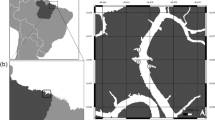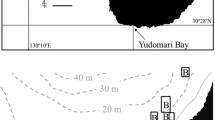Abstract
To examine the behavioral adjustment of a generalist marine top predator to variability of their prey, we studied the foraging behavior of Japanese cormorants (Phalacrocorax filamentosus) breeding at Teuri Island, Hokkaido, in years of contrasting demersal and epipelagic prey composition. We used radio telemetry and ship-based surveys to determine behavior and at-sea distribution during three summers (1996–1998). The cormorants fed on epipelagic anchovy (Engraulis japonicus) and sandlance (Ammodytes personatus) in 1998 (year of epipelagic diet), while they fed on benthic rock fish (Sebastes spp.) and flatfish (Pleuronectidae) and nearshore-living naked sandlance (Hypophychus dybowskii), as well as epibenthic greenling (Hexagrammidae) in 1996 and 1997 (year of demersal diet). Cormorants engaged in larger feeding groups, visited more feeding sites, and stayed at each feeding site for a shorter period in the year of epipelagic diet than in the years of demersal diet. The cormorants made long foraging trips and fed in the mainland coastal habitat, distant from the colony, in the years of demersal diet. Individual radio-tracked birds fed over the wide area between the islands and mainland, in the year of epipelagic diet, while most individuals specialized in mainland or island coastal habitats in the years of demersal diet. Behavioral adjustment of Japanese cormorants might allow them to exploit both unpredictable epipelagic and predictable benthic prey efficiently.




Similar content being viewed by others
References
Amaoka K, Nakaya K, Yabe M (1995) The fishes of northern Japan (in Japanese). Kitanippon Kaiyo Centre, Sapporo
Aoki I, Inagaki T (1988) Photographic observations on the behaviour of Japanese anchovy, Engraulis japonica, at night in the sea. Mar Ecol Prog Ser 43:213–221
Aoyama T, Mimoto K (1970) The distribution and abundance of Japanese anchovy in Tachibana Bay. In: Report of the investigations of hydrographic conditions and fish school distribution in Tachibana Bay. Seikai Reg. Fish. Res. Lab., Nagasaki, pp 93–118
Ashmole NP (1971) Seabird ecology and marine environment. In: Fraser DS, King JR (eds) Avian biology, vol I. Academic, New York, pp 224–271
Barrett RT, Røv N, Loen J, Montevecchi WA (1990) Diets of shags, Phalacrocorax aristotelis, and cormorants, P. carbo, in Norway and possible implications for gadoid stock recruitment. Mar Ecol Prog Ser 66:205–218
Cairns DK (1987) The ecology and energetics of chick provisioning by black guillemots. Condor 89:627–635
Coyle KO, Hunt GL Jr, Decker MB, Weingartner TJ (1992) Murre foraging, epibenthic sound scattering and tidal advection over a shoal near St. George Island, Bering Sea. Mar Ecol Prog Ser 83:1–14
Crawford RJM, Dyer BM (1995) Responses by four seabird species to a fluctuating availability of Cape anchovy, Engraulis capensis, off South Africa. Ibis 137:329–339
Davoren GK (2000) Variability in foraging in response to changing prey distribution in rhinoceros auklets. Mar Ecol Prog Ser 198:283–292
Davoren GK, Montevecchi WA, Anderson JT (2003a) Distribution patterns of a marine bird and its prey: habitat selection based on prey and conspecific behaviour. Mar Ecol Prog Ser 256:229–242
Davoren GK, Montevecchi WA, Anderson JT (2003b) Search strategies of a pursuit-diving marine bird and the persistence of prey patches. Ecol Monogr 73:463–481
Duffy DC, Wilson RP, Wilson MP (1987) Spatial and temporal patterns of diet in the Cape cormorant off southern Africa. Condor 89:830–834
Golet GH, Kuletz KJ, Roby DD, Irons DB (2000) Adult prey choice affects chick growth and reproductive success in pigeon guillemots. Auk 117:82–91
Grémillet D, Argentin G, Schulte B, Culik BM (1998) Flexible foraging techniques in breeding cormorants, Phalacrocorax carbo, and shags, Phalacrocorax aristotelis: benthic or pelagic feeding? Ibis 140:113–119
Grémillet D, Wilson RP, Sandra S, Gary Y (1999) Three-dimensional space utilization by a marine predator. Mar Ecol Prog Ser 183:263–273
Grover JJ, Olla BL (1983) The role of the rhinoceros auklet (Cerorhinca monocerate) in mixed-species feeding assemblages of seabirds in the strait of Juan de Fuca, Washington. Auk 100:979–982
Hoffman W, Heinemann D, Wiens JA (1981) The ecology of seabird feeding flocks in Alaska. Auk 98:437–456
Hobson ES (1986) Predation on the Pacific sandlance, Ammodytes hexapterus (Pisces: Ammodytidae), during the transition between day and night in southeastern Alaska. Copeia 1:223–226
Hunt GL Jr (1991) Marine ecology of seabirds in polar oceans. Am Zool 31:131–142
Irons DB (1998) Foraging area fidelity of individual seabirds in relation to tidal cycles and flock feeding. Ecology 79:647–655
Ishigaki T, Kaga Y, Onodera T (1957) A few information concerning “shiwa-ikanago” (Hypoptychus dybowskii Steindachner) in waters around Hokkaido (in Japanese). Mon J Fish Exp Stn 14:324–334
Ishikawa K, Watanuki Y (2002) Sex and individual differences in foraging behavior of Japanese cormorants. J Ethol 20:49–54
Johnsgard PA (1993) Cormorants, darters, and pelicans of the world. Smithsonian Institution, Washington, D.C., USA
Kato A, Watanuki Y, Naito Y (1998) Benthic and pelagic foraging of two Japanese cormorants, determined by simultaneous recording of location and diving activity. J Yamashina Inst Ornithol 29:83–90
Kato A, Watanuki Y, Naito Y (2001) Foraging and breeding performance of Japanese cormorants in relation to prey type. Ecol Res 16:745–758
Kirkwood R, Robertson G (1997) Seasonal change in the foraging ecology of Emperor penguins on the Mawson Coast, Antarctica. Mar Ecol Prog Ser 156:205–223
Litzow MA, Piatt JF, Abookire AA, Prichard AK, Robards MD (2000) Monitoring temporal and spatial variability in sandeel (Ammodytes hexapterus) abundance with pigeon guillemot (Cepphus columba) diets. ICES J Mar Sci 57:976–986
Litzow MA, Piatt JF, Prichard AK, Robby D (2002) Response of pigeon guillemots to variable abundance of high-lipid and low-lipid prey. Oecologia 132:286–295
Maritime Safety Agency (1972) Bathymetric chart no. 6321. Maritime Safety Agency, Tokyo
Mizushima T, Torisawa T (2003) Fisheries and aquatic life in Hokkaido (in Japanese). Hokkaido Shinbun, Sapporo
Monaghan P (1996) Relevance of the behaviour of seabirds to the conservation of marine environments. Oikos 77:227–237
Montevecchi WA (1993) Birds as indicators of change in marine prey stocks. In: Furness RW, Greenwood JJD (eds) Birds as monitors of environmental change. Chapman and Hall, London, pp 217–266
Nagasawa K, Torisawa M (1991) Fishes and marine invertebrates of Hokkaido: biology and fisheries (in Japanese). Kita-nihon Kaiyo Center, Sapporo
Natsume M (1998) Fishing depth and the water temperature of the midwater long-line fishery of walleye pollock in the coastal waters of Hiyama Subprefecture, Hokkaido (in Japanese). Sci Rep Hokkaido Fish Exp Stn 53:1–8
Ohshimo S, Hamatsu T (1996) Vertical distribution and acoustic estimation of biomass of walleye pollock, Theragra chalcogramma, and anchovy, Englauris japonicus, in the Pacific coast of eastern Hokkaido. Bull Hokkaido Natl Fish Res Inst 60:225–237
Partridge L, Green P (1985) Intraspecific feeding specializations and population dynamics. In: Sibly RM, Smith RH (eds) Behavioural ecology. Blackwell, Oxford, pp 207–226
Quintana F (2001) Foraging behaviour and feeding locations of rock shags, Phalacrocorax magellanicus, from a colony in Patagonia, Argentina. Ibis 143:547–553
Schneider DC (1997) Habitat selection by marine birds in relation to water depth. Ibis 139:175–178
Schneider DC, Hunt GL Jr (1982) Carbon flux to seabirds in waters with different mixing regimes in the southeastern Bering Sea. Mar Biol 67:337–344
Schreiber RM, Clapp RB (1987) Pelecaniform feeding ecology. In: Croxall JP (ed) Seabirds: feeding ecology and role in marine ecosystems. Cambridge University Press, Cambridge, pp 173–188
Shinomiya A, Ezaki O (1991) Mating habits of the rockfish Sebastes inermis. Environ Biol Fishes 30:15–22
Starr RM, Heine JN, Felton JM, Cailliet GM (2002) Movements of bocaccio (Sebastes paucispinis) and green spotted (S. chlorostictus) rockfishes in a Monterey submarine canyon: implications for the design of marine reserves. Fish Bull (Wash DC) 100:324–337
Suryan RM, Irons DB, Kaufman M, Benson J, Jodice PGR, Roby DD, Brown ED (2002) Short-term fluctuations in forage fish availability and the effect on prey selection and brood-rearing in the black-legged kittiwake, Rissa tridactyla. Mar Ecol Prog Ser 236:273–287
Takahashi A, Kuroki M, Niizuma Y, Kato A, Saito S, Watanuki Y (2001) Importance of the Japanese anchovy Engraulis japonicus to breeding rhinoceros auklets, Cerorhinca monocerate, on Teuri Island, Sea of Japan. Mar Biol 139:361–371
Toba Y, Tomizawa K, Kurasawa Y, Hanawa K (1982) Seasonal and year-to-year variability of the Tsushima-Tsugaru warm current system with its possible cause. La Mer (Bull Soc Franco-Jpn Oceanogr, Tokyo) 20:41–51
Tominaga O, Mabuchi M, Ishiguro H (1994) Movement and growth of wild and hatchery-reared Japanese flounder, Paralichthys olivaceus, in the Sea of Japan off northern Hokkaido (in Japanese). Suisanzoshoku 42:593–600
Tremblay Y, Cherel Y (2000) Benthic and pelagic dives: a new foraging behaviour in rockhopper penguins. Mar Ecol Prog Ser 204:257–267
Wanless S, Harris MP, Morris JA (1991) Foraging range and feeding locations of shags, Phalacrocorax aristotelis, during chick rearing. Ibis 133:30–36
Wanless S, Grémillet D, Harris MP (1998) Foraging activity and performance of shags, Phalacrocorax aristotelis, in relation to environmental characteristics. J Avian Biol 29:49–54
Watanuki Y, Kato A, Naito Y (1996) Diving performance of male and female Japanese cormorants. Can J Zool 74:1098–1109
Watanuki Y, Takahashi A, Sato K (2003) Feeding area specialization of chick-rearing Adélie penguins, Pygoscelis adeliae, in a fast sea-ice area. Ibis 145:558–564
Acknowledgements
We would like to thank M. Aotsuka, Y. Fukuda, H. Ichikawa, M. Kuroki, M. Chyochi, E. Hayashi, Y. Niizuma, M. Koga, K. Iseki, T. Deguchi, T. Kagami and K. Yoda for field assistance and T. Deguchi for analysis of otoliths, and Y. Niizuma, H. Mitamura, O. Yamamura, R. Kawabe, K. Nashida and M.A. Litzow for information on fish distribution patterns. R. Suryan, G. Hunt and two anonymous reviewers provided invaluable comments on the manuscript. This work was supported by a grant-in-aid (no. 09680497) from the Japanese Ministry of Education, Science and Culture, a 21th Century COE Program on “Neo-Sciences of Natural History” (program leader: H. Okada) financed by the Ministry of Education, Culture, Sports, Sciences and Technology, Japan, and funding from the Sumitomo Foundation.
Author information
Authors and Affiliations
Corresponding author
Additional information
Communicated by T. Ikeda, Hakodate
Rights and permissions
About this article
Cite this article
Watanuki, Y., Ishikawa, K., Takahashi, A. et al. Foraging behavior of a generalist marine top predator, Japanese cormorants (Phalacrocorax filamentosus), in years of demersal versus epipelagic prey. Marine Biology 145, 427–434 (2004). https://doi.org/10.1007/s00227-004-1345-3
Received:
Accepted:
Published:
Issue Date:
DOI: https://doi.org/10.1007/s00227-004-1345-3




